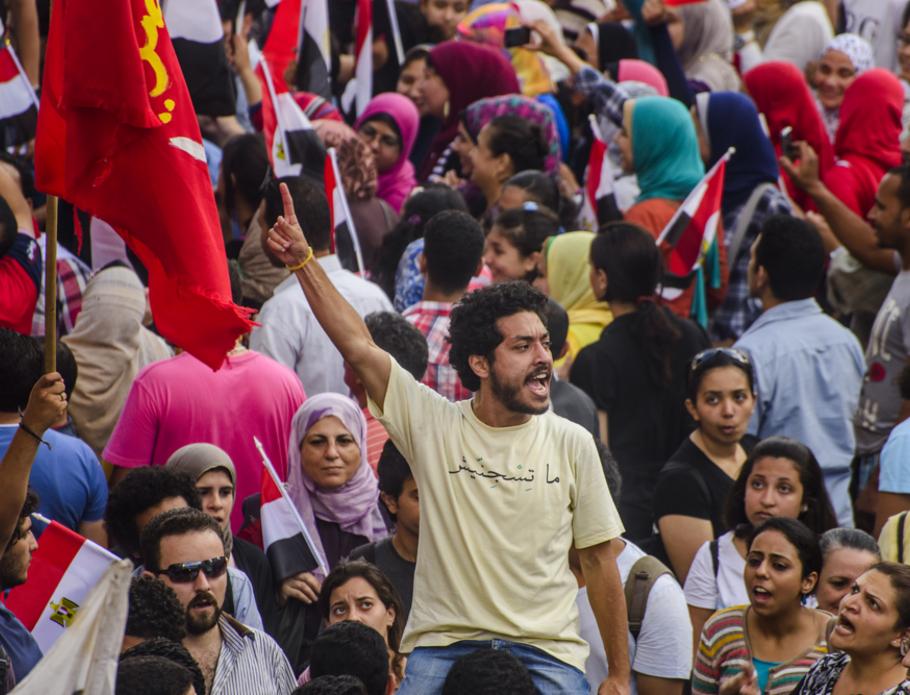The Arab youth is not a monolith: How do you empower the Middle East’s millennials and Gen Z?
Photo: Egyptian activist protesting against Morsi - Alexandria, Sidi Gaber, Egypt, 30 June 2013 / MidoSemsem / Shutterstock.com
At a median age of 23 in 2010, Muslims are the youngest of all major religious groups in the Middle East. The aspirations of this group are defined by context, socio-economic development, prosperity and literacy. How can stakeholders in the Islamic Economy empower the region’s Muslim millennials and Gen Z?
The aspirations of Middle Eastern youth have not changed significantly since the Arab Spring in 2011, according to one of the region’s longest-running youth surveys. Key findings of this year’s Asda’a Burson-Marsteller 16-country Arab Youth Survey (pdf), now in its eighth year, show a preference for stability over democracy, but with a positive shift in attitudes towards private sector employment and entrepreneurship.
Most respondents to the 2016 edition of the survey agreed that the new generation is more entrepreneurial than previous ones, with 36 percent saying they intend to start a business in the next five years. 54 percent overall and 62 percent in the Gulf Cooperation Council (GCC) agree that the younger generation is more likely to start a business than previous generations. Experts and analysts agree that this presents challenges to the governments in the region.
Abdulla Al Awar, CEO of the Dubai Islamic Economy Development Centre, told Salaam Gateway that by being a part of the “fertile and enabling ecosystem” of the Islamic Economy, young entrepreneurs and investors from the GCC and the wider Middle East region are, in fact, best suited to develop innovative products and services that cater to Muslim consumers in other countries. The areas to focus on, says Al Awar, are environmental concerns, job creation, healthcare and food safety, for the greater good of the community rather than for individual profit.

Photo: DUBAI - UAE - APRIL 06 2012: An unidentified person waving the peace flag during the "March For Peace" event organized by Dubai Islamic Department and Govt. of Dubai on April 06 2012 in Zabeel, Dubai / creativei images / Shutterstock.com
Tirad Mahmoud, Group CEO of Abu Dhabi Islamic Bank, underscored the need for governments to become enablers of the Gen Z aspirations. Speaking at the Global Islamic Economy Summit 2016 in October, he said: "The government is a regulator; they create the environment for the private sector to take responsibility. Then, 80 percent of execution is in [private sector] hands. An institution represents a community, which, in turn, creates the country.”
This young generation more than any other, experts say, is equipped to create solutions for themselves and for the communities they represent. Internationally, demographics experts say Gen Z is seen as ambitious realists. According to EY findings shared at GIES 2016, millennials (born between 1980 and 2000) are “entrepreneurial, creative, self-centred” and dependent on others, whereas Gen Z (the post-millennial) is “persistent, innovative, self-aware and self-reliant.”
This broad definition applies to the Middle East’s Muslim youth as well.
Sunil John, CEO of Asda’a Burson-Marsteller, told Salaam Gateway: “Our survey results certainly bear that out. Whether that’s a result of the generational shift, a response to the realities of the Middle East today, or a combination of both, isn’t yet entirely clear.
However, some things have not changed. “Young people want opportunities. They want good jobs, and a secure future. That hasn’t changed in the eight years of conducting the survey,” John said.
Available lending, improved education and training, along with more effective regulation and introducing a robust bankruptcy law were seen as initiatives that governments could take to promote entrepreneurship.
GROWTH GAPS
The need to find solutions increases in complexity due to the fact that Muslim youth is not a monolith; aspirations and their realisation are defined by context.
At one end of the spectrum, among millennial Muslims, there are the social media-savvy digital natives of the Islamic Economy engaging as consumers and entrepreneurs with various sectors. On the other hand, some of the countries with the largest population growth and lowest median ages are among the poorest in the world, presenting a challenge for decision-makers to create effective strategies to harness the opportunity of this Muslim youth bulge.
Pew Research Center’s population projections show that in 2030, the Muslim-majority countries with the highest proportion of youth and young adults (ages 15-29) will be relatively poorer ones such as Burkina Faso, Senegal, Sierra Leone and Mali, where about three in 10 will be in that age group.
The highest median ages (32-30) are found in countries with comparatively higher GDP per capita such as the UAE, Kuwait, Qatar and Albania.
With differing rates of population growth, the distribution of the population is also expected to change – in 20 years, for example, more Muslims are likely to live in Nigeria than in Egypt.
Countries in the Middle East and North Africa (MENA) region, which have and will continue to have the highest percentage of Muslim-majority countries, will also see the widest demographic range.
“There are big regional differences in thinking. Youth in the GCC nations, for example, are far more confident about their financial futures than other young Arabs, but they’re also far more concerned about declining oil prices,” John says.
“The MENA region is vast, and our survey encompasses 16 countries, each of which is unique in terms of its economy, its opportunities, political systems and other factors. The survey reveals that Arab youth are not at all a homogeneous group,” he added.

Photo: DAMMAM, SAUDI ARABIA - JULY 8: On a red carpet with rows of desks and chairs, college students prepare for an exam on 8 July, 2015 in Dammam, Saudi Arabi / John Grummitt / Shutterstock.com
FORGING LIFE PATHS, NOT CAREERS
Education
The majority of young Arabs in the survey – 58 percent – wanted to further their education, be it university, vocational training or post-graduate degree. In North Africa, 73 percent intended to further their education, against 61 percent in the GCC and just 41 percent in the Levant.
The reasons for not wanting to pursue higher education were varied – 40 percent of young people in the Levant said the high cost of further education was a factor, whereas in North Africa 19 percent were concerned by teaching standards. In the Gulf region, 62 percent preferred to start a career rather than continue education.
Employment
The second key area of focus was employment. “In some regions, more than others, there was high scepticism about jobs in the market,” John said. Yemen, Libya, Palestine, Tunisia, Lebanon and Iraq emerged as the most sceptical countries.
In the GCC, where governments have traditionally employed the majority of the national workforce, only 15 percent of young people said they would prefer to work in the private sector, as opposed to 70 percent who said they would prefer government jobs.
Job opportunities or entrepreneurship are considered more a life path than a career, with wide-ranging future ramifications. John said: “The biggest problems, as seen by youth today, concern terrorism and a perceived lack of opportunities. These are actually connected, as our key findings from this year’s survey show. The top obstacles are identified as the rise of Da’esh and the threat of terrorism, closely followed by unemployment, civil unrest and the rising cost of living.”
Terrorism
Governments in the region need to deal with critical challenges brought about by falling oil prices, unemployment and groups considering violence as a way of life. From the survey, John said, “[Young people] consider a lack of opportunities to be the main driver of recruitment for Da’esh. In total, fewer than half of young Arabs believe they have good opportunities available to them.”
“And, when we broke it down, and looked at the countries where youth felt the least amount of opportunity, we see a strong correlation between the countries where Da’esh is most active and those where youth feel the least amount of opportunity. Only 2 percent of Yemenis, 7 percent of Libyans, 20 percent of Palestinians, 21 percent of Lebanese and 28 percent of Tunisians felt that they had good job opportunities,” he added.
UAE MODEL
To address the needs of millennials and Gen Z, the Islamic Economy needs to create relevant and specific socio-economic infrastructure. Perhaps the answer lies in the UAE model of thinking by the young, for the young.
Eng. Ali Al Nuaimi, Senior Nuclear Professional and Member of the Emirates Youth Council, says that an effective youth strategy involves participation and empowerment."Our initial strategy is to bring in the youth via local councils; make them feel a sense of responsibility, help them understand that the more they participate the better is their own future. We trust the youth for not only their own but the country's future as well.
“Then comes empowerment. You give them the opportunity to effect change. When the youth see that their leaders are only a few years older than they are, they feel they can influence policy and the direction in which the country is going," Al Nuaimi said at GIES 2016 last month.
The relatively young country, at 45 years of age, this year appointed a 22-year-old Minister of State for Youth and started a #NationalYouthDialogue in September.
Its policies have certainly struck a chord. Despite their many differences, the youth in the survey listed the UAE as the country of choice when asked where in the world they would prefer to live. It also was the number one country that they said they would like their country to emulate.
© SalaamGateway.com 2016 All Rights Reserved

Shalini Seth, Media ME